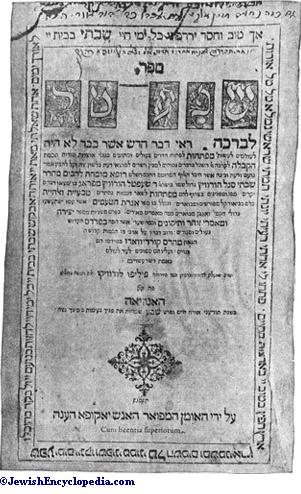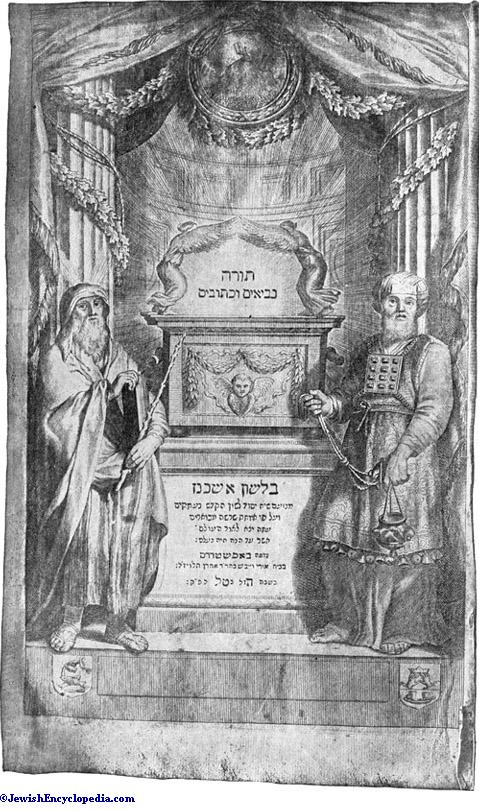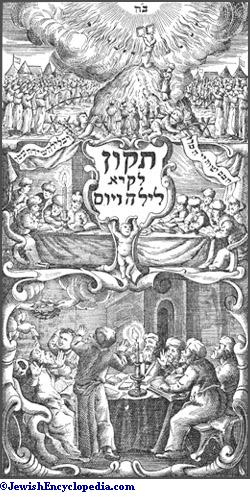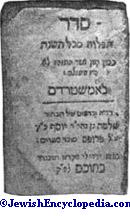Title-Page
 From Jewish Encyclopedia (1906)
From Jewish Encyclopedia (1906) Title-Page:

Hebrew incunabula, like manuscripts, were mostly provided with colophons, which served as title-pages. The title of the Soncino edition of Berakot, 1483, is given in the printer's colophon. The title-page of Ibn Gabirol's (or Jedaiah Bedersi's?) "Mibḥar ha-Peninim" (Soncino, 1484) is preceded by a short preface. In Naḥmanides' commentary on the Pentateuch (Lisbon, 1489) the title, "Ḥiddushe Torah," precedes the preface. In "Seder ha-Taḥanunim Asher Nahagu Bene Roma" (= The Order of Devotions According to the Custom of Rome) the title is given in the colophon (Soncino, 1487). In David Ḳimḥi's "Sefer ha-Shorashim" (Naples, 1491) the title, on the first page, is surrounded by a wood-engraving.
Decorations.In the early sixteenth century the colophon still predominated. The title of the "Sefer Minhag Abot," the condensed liturgical code of Zedekiah b. Abraham's "Shibbole ha-Leḳeṭ," appears in the colophon (Mantua, 1514). About this period the titles of books began to appear on the first page, next to the cover. In the first complete Babylonian Talmud, which was printed by Bomberg in Venice, 1520-23, the title on the first page occupies a narrow space of five lines, a little above the center, and, translated, reads: "Masseket Niddah, with Commentaries of Rashi, Tosafot, Extracts of Decisions in Tosafot, Commentary on the Mishnah by Maimonides, Commentary and Decisions by Asheri. Printed by Daniel Bomberg, in the year 5280, in Venice." Soon, however, the titles began to occupy the entire page, some being bordered with ornamental wood-or metal-engravings of flowers, or of Moses, Aaron, David, and Solomon, or of angels, deer, and lions. The original engravings were sometimes used by non-Jewish artists, which accounts for the non-Jewish character of some of the title-pages. The borders included the printer's device and marks. The printers at Prague in the sixteenth century decorated their title-pages in the style of an illuminated manuscript. As a popular title-page design, the entrance to the Temple, above which was inscribed "This gate of the Lord, into which the righteous shall enter" (Ps. cxviii. 20), with the pillars of Jachin and Boaz, occupied high rank. The Amsterdam, 1666, "Tiḳḳun," for night reading, has an engraved title-page with a representation of Shabbethai Ẓebi and his disciples. Isaac Aboab's "Menorat ha-Ma'or" (Amsterdam, 1722) has a very elaborately engraved title-page. Maimonides' "Sefer ha-Miẓwot" (with Judæo-German translation by J. Landau, Prague, 1798) has the entire first title-page, including the title and inscription of the book, engraved, and contains the figures of David and Solomon, the Levites' musical instruments, the Ark, and the candlestick.
Frequently two title-pages were used, the first being ornamented and giving the name and contents of the book in general terms, the second giving a fuller description in plain type. The Amsterdam, 1679, edition of the Bible, which has a Judæo-German translation, has a second engraved title-page. Often the title-page was artistically very attractive; the largest types were used for the title. The Talmud published by Schapira in Slobuta (1817-22) gives the titles of the treatises and the special commentaries (not printed in former editions) and the name of Slobuta in red. In the second Slobuta edition, 1834-36 (only Berakot, Shabbat, and 'Erubin being published), there were two title-pages, some lines being in red and some in black; the Wilna-Grodno edition (1832-52) followed this style. The matter on the title-page is sometimes spaced and sometimes crowded. The Venice Abudarham of 1566 has the author's preface of eighteen lines on the title-page. Joshua Falk Cohen's "Abne Yehoshua'," the first rabbinical work published in America (New York, 1860), has the description of the contents, on the title-page, set in the form of a triangle. A number of modern books use vowel-points on the title-page.


Some title-pages misrepresent the contents of the book. The title-page of the Bomberg Pentateuch, Venice, 1524, calls for Ibn Ezra's commentary on the Five Rolls, which, however, is not in the book. The same thing occurred in the case of Isaac Abravanel's commentary on the Megillot (Venice, 1573). Judah ha-Levi's "Cuzari," with translation and commentary by David Cassel (Leipsic, 1853), has a second title-page, dated 1841, which states that part of the commentary was written conjointly by H. Jolowicz and D. Cassel. Moses Ḥayyim Luzzatto's "Migdal 'Oz" ( ib. 1854) mentions "F. Delitzschii prolegomena" in the title-page, but the latter is not included in the book.
Some old works were supplied with new title-pages. Elijah Levita's "Sefer ha-Tishbi" (Isny, 1541) was given a new title-page and preface at Basel in 1557. The title-page bearing the imprint of Frankfort-on-the-Oder, 1595, covers the edition of Wittenberg, 1587, by Crots. The "Yosippon," with the title-page of Leipsic, 1710, is the old edition of Gotha, 1707. The commentary of Abravanel on the Early Prophets with the title-page of Frankfort-on-the-Main, 1736, is the Leipsic edition of 1686. This device of changing the title-page was probably due to the bookseller's desire to mislead the purchaser; or perhaps the old title-pages were missing and were replaced by a second printer. Still it is difficult to explain why one edition of a certain date and place should have various title-pages, as in the case of Ibn Shu'aib's "Ḳol Bokim," a commentary on Lamentations (Venice, 1589), and Ḥayyim Abraham Ostrosa's "Sefer Ben le-Abraham" (Salonica, 1826), some copies of which read "Sefer Ben Abraham," omitting the "le"; perhaps the printer dropped that letter from the form before he had finished the edition.


Some of the errors in the title-pages affect the name of the author. In Moses b. Elijah Galina's "Ḥokmat ha-Parẓuf" (Amsterdam, 1658) the name reads "Elijah ben Moses." In Elijah Alfandari's "Seder Eliyahu Rabbah," responsa (Constantinople, 1719), the name "Shabbethai" on the title-page is an error. Mistakes in dates of publication, especially in acrostics, are numerous. Sometimes the date on the title-page is different from that in the colophon, or the two title-pages disagree. For example, the Amsterdam, 1705, edition of the Bible has a second title-page dated 1700-3. Elijah b. Joseph Trillinger's "Mishnat R. Eli'ezer" (Frankfort-on-the-Oder, 1707) gives the correct date in the colophon, but on the title-page of the first volume the date 1655 is given in acrostic. On some title-pages the dates are incorrectly given, as in the Ṭur Ḥoshen Mishpaṭ of Venice, 1567, in which the date given is 5027, instead of 5327. A similar mistake occurred in Joseph b. Ḥayyim Jabez's commentary on the Psalms (Salonica, 1571), in which the words "Shelosh Me'ot" (= "three hundred") are omitted.
- De Vinne, Title-Pages as Seen by a Printer, New York, 1901.
Categories: [Jewish encyclopedia 1906]
↧ Download as ZWI file | Last modified: 09/04/2022 17:33:31 | 17 views
☰ Source: https://www.jewishencyclopedia.com/articles/14409-title-page.html | License: Public domain
 ZWI signed:
ZWI signed: KSF
KSF